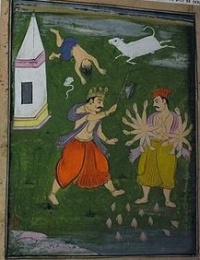Parashurama: Unterschied zwischen den Versionen
Adm1 (Diskussion | Beiträge) |
Adm1 (Diskussion | Beiträge) |
||
| Zeile 8: | Zeile 8: | ||
== Legende == | == Legende == | ||
The aim of his birth was to deliver the world from the arrogant oppression of the ruling caste, the Kshatriyas. He killed all the male Kshatriyas on earth and filled five lakes with their blood. After destroying the Kshatriya kings, he approached assembly of learned men to find a way of penitence for his sins. He was advised that, to save his soul from damnation, he must hand over the lands he had conquered to the Brahmins. He did as they advised and sat in meditation at Gokarna. There, Varuna - the God of the Oceans and Bhumidevi - Goddess of Earth blessed him.<br> | The aim of his birth was regarding to the [[Mahabharata]] to deliver the world from the arrogant oppression of the ruling caste, the Kshatriyas. He killed all the male Kshatriyas on earth and filled five lakes with their blood. After destroying the Kshatriya kings, he approached assembly of learned men to find a way of penitence for his sins. He was advised that, to save his soul from damnation, he must hand over the lands he had conquered to the Brahmins. He did as they advised and sat in meditation at Gokarna. There, Varuna - the God of the Oceans and Bhumidevi - Goddess of Earth blessed him.<br> | ||
From Gokarna he reached Kanyakumari and threw his axe northward across the ocean. The place where the axe landed was Kerala. It was 160 katam (an old measure) of land lying between Gokarna and Kanyakumari. Puranas say that it was Parasuram who planted the 64 Brahmin families in Kerala, whom he brought down from the north in order to expiate his slaughter of the Kshatriyas. According to the puranas, Kerala is also known as Parasurama Kshetram, ie., 'The Land of Parasurama', as the land was reclaimed from sea by him. | From Gokarna he reached Kanyakumari and threw his axe northward across the ocean. The place where the axe landed was Kerala. It was 160 katam (an old measure) of land lying between Gokarna and Kanyakumari. Puranas say that it was Parasuram who planted the 64 Brahmin families in Kerala, whom he brought down from the north in order to expiate his slaughter of the Kshatriyas. According to the puranas, Kerala is also known as Parasurama Kshetram, ie., 'The Land of Parasurama', as the land was reclaimed from sea by him. | ||
[[Datei:parusharam2.jpg|200px|thumb|right| Viṣṇu als Paraśurāma mit Angriff auf Kartavirya mit den Toten Jamadagi und seinrr Kuh Sabala ]] | [[Datei:parusharam2.jpg|200px|thumb|right| Viṣṇu als Paraśurāma mit Angriff auf Kartavirya mit den Toten Jamadagi und seinrr Kuh Sabala ]] | ||
== Literatur == | == Literatur == | ||
Version vom 8. Januar 2014, 17:41 Uhr
( in Vorbereitung )
Parashurama (Rama mit einer Axt) wird als indirekter Avatar, den Vishnu nur durchdringt, angesehen. ER soll als als kämpfender Kshatriya versucht ahben, die göttliche Ordnung wieder zu installieren. Die Axt erhielt er nach langer Askese und Gebet von Shiva, der ihn auch im Kampf unterrichtete.
Legende
The aim of his birth was regarding to the Mahabharata to deliver the world from the arrogant oppression of the ruling caste, the Kshatriyas. He killed all the male Kshatriyas on earth and filled five lakes with their blood. After destroying the Kshatriya kings, he approached assembly of learned men to find a way of penitence for his sins. He was advised that, to save his soul from damnation, he must hand over the lands he had conquered to the Brahmins. He did as they advised and sat in meditation at Gokarna. There, Varuna - the God of the Oceans and Bhumidevi - Goddess of Earth blessed him.
From Gokarna he reached Kanyakumari and threw his axe northward across the ocean. The place where the axe landed was Kerala. It was 160 katam (an old measure) of land lying between Gokarna and Kanyakumari. Puranas say that it was Parasuram who planted the 64 Brahmin families in Kerala, whom he brought down from the north in order to expiate his slaughter of the Kshatriyas. According to the puranas, Kerala is also known as Parasurama Kshetram, ie., 'The Land of Parasurama', as the land was reclaimed from sea by him.
Literatur
Referenzen
Weblinks
- Wiki zum Parashurama
